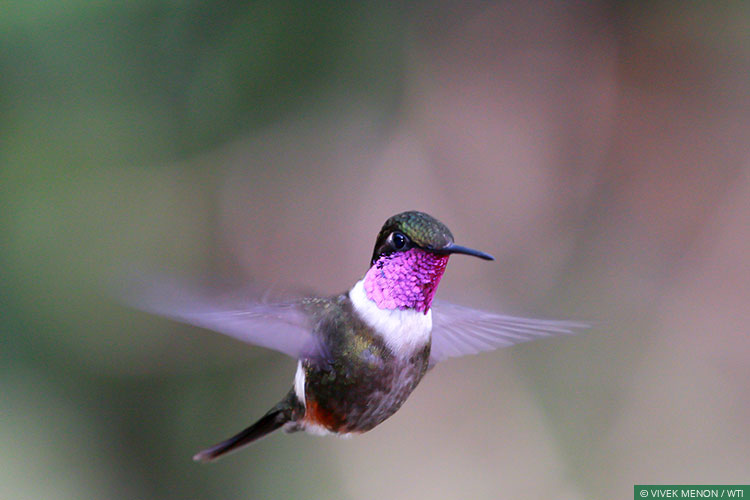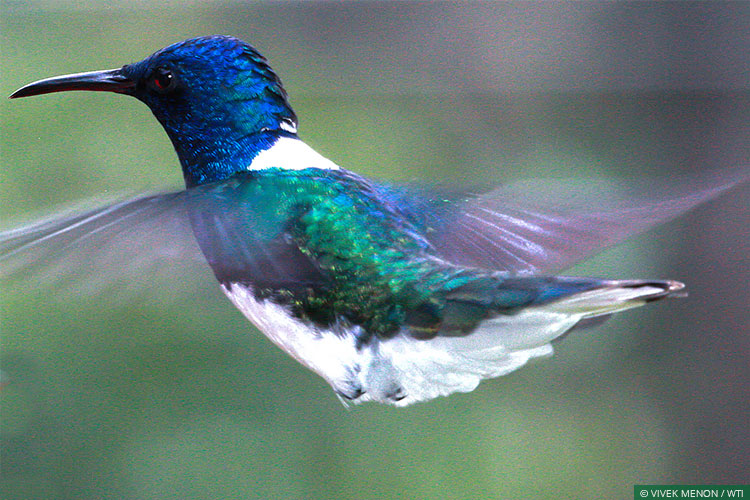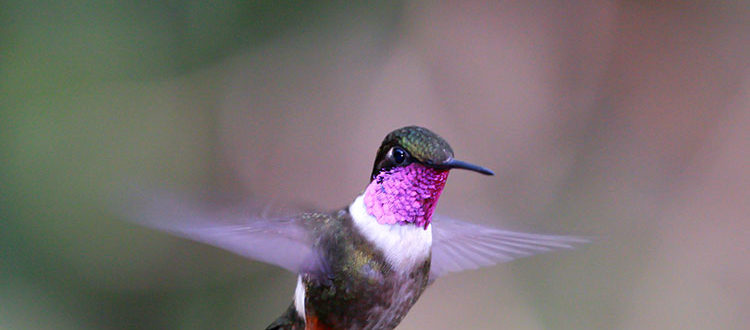H is for Hummingbird, S for Sunbird
By Vivek Menon
In my balcony, a sunbird is building its gossamer nest; spider webs and silken floss binding its home to the stoutest branch of my Bougainvillea. I approach the nest and the male rushes in, purple chest flashing indignation, bullying, scolding and flapping his wings. The lady has none of the brazen display of the male. She is far more discreet, creeping in through an adjacent balcony, past the air-conditioning ducts and geranium pots as if she were about to commit a grand burglary. Yet her stealth leads her only to her own finely woven purse, which has taken her seven days to build, three days to desert (all sunbirds do this to deceive predators) and then a day to sneak in and lay her little treasure of two pale green-splotched eggs. I sit in my grandfather chair and watch them, sipping my Colombian coffee. Is it the whir of wings or the waft of caffeine, I am unsure, but I float to several weeks ago, over the Himalaya, past two continents and into a world of avian jewels that inhabit the rarefied air of the Cordillera Central of the Andes in Colombia.

A Purple-throated Woodstar in Finca Alexandria in Columbia. Endemic to the Americas, hummingbirds are a huge attraction for bird lovers.
A World of Wing Beats
I am being hosted by Raul Nieto and Elsa Ruiz, the Papa and Mama of Hummingbirds of Cali. Finca Alexandria is their home, as it is to over a hundred different species of wondrous Colombian avifauna. There is the splashily-extravagant Multicoloured Tanager, the large and stately Colombian Chachalaca, gaudy Red-headed Barbets and a flurry of hummingbirds. And yet the Hummingbird Paradise was created because the couple ran out of meat to feed raptors. “I was fascinated by hawks and eagles,” Raul confides, “and I used to toss up chunks of meat to watch them swoop down and feed on my offerings.”
“I am glad that stopped,” Elsa interrupts, and I guess it has something to do with the economy of their homestead. “I moved on instead to hummingbird feeders,” Raul says. “Much more economical,” I agree and the brain flashes instantly to another friend, across several waters, who has the largest private collection of parrot species in the world. “But why parrots, Wolfgang?” I once asked him. “Because I learned from my father that keeping elephants is more expensive,” he said without blinking, his cerulean eyes nailing me and my inane query to my own private crucifix. Wolfgang and Raul are utterly different in all ways, except one: they are both incredibly passionate about birds.
At Raul and Elsa’s Finca Alexandria, 18 km from Cali, I walk-crawl between some two dozen red tubes and bowls growing out of their garden like plastic offerings to the avian world. Each feeder spouts homemade nectar: sugar and water condensed to a syrup that hummingbirds love. The air is thick with wing beats.
“But why parrots, Wolfgang?” I once asked. “Because I learned from my father that keeping elephants is more expensive,” he said without blinking.
The Bee Hummingbird, the smallest of the hummers, has been recorded at 200 wing beats a second! The bee hummer is not a Colombian bird I believe, but does it really matter? The average hummer does something like 75 without breaking sweat, 50 is for beginners. That is wing beats… every second! My Indian brain whirs only as fast as a sunbird, a magnitude slower, and the strain of keeping up with the concept of hummer flights makes me close my eyes. As I open them, a White-necked Jacobin whirs right in front of me, a Long-tailed Sylph is flicking its long metallic green tail first right and then left in a pendular movement mid-air, and just beyond, two tiny Purple-throated Woodstars feed on Raul’s mixture. I swivel just my neck, rendered statuesque in admiration like a wonderstruck lover, and from that pose alone count 45 birds of 13 different species. Raul has counted 100 species sitting there, he says. “I am glad you gave up the hawks,” I counter. And in my mind’s eye flashes the brilliance of Helen Macdonald’s prose in H is for Hawk. “They were things of death and difficulty,” she writes of a goshawk, “spooky, pale-eyed psychopaths that lived and killed in woodland thickets”. If only her father had trained her on hummingbirds. H is for Hummers. A totally different vision and world would have awaited her. The book would have been so different as well.

Jacobin, White-necked (Florisuga mellivora), Finca Alexandria, Cali, Columbia
A Network of Feeders
India does not have hummers but convergent evolution has given us our sunbirds. With hummingbirds on your mind the sunbirds look large and clumsy; their wing beats dull and lethargic, country yokels of speed aerobatics. But in themselves they are exquisite miniature art pieces that come in iridescent colours and fine oriental detail. They have similar tubular tongues with a feathery tip that can soak up floral offerings. Hummers are closely related to swifts and the speed of their wing beats is testament to that evolutionary proximity. They can feed without perching like swifts do as well. Sunbirds are, rather ironically, closest to crows, lacking their size and monochrome aspect, but perching like other passerines do in the quest for nectar. Interestingly, oriental plants have evolved to have bracts (or modified leaves) that sunbirds can perch on, while neo-tropical ones from similar families eschew this frill as hummingbirds do not require that perch.
India needs a convergent evolution of sunbird feeders and bird attractant farmlands that would bring in people to watch the beauty of avifauna.
Evolution has given us our own hummers. What India does not have is a convergent evolution of sunbird feeders and bird attractant farmlands that would bring in people to watch the beauty of the avifauna as Colombia does. I turn to the companions who have brought me to this little bit of paradise: Carlos Wagner, the musically-named brain behind the Cali Bird Fest, as solitary as the cliff-dwelling barranquero (the local name for the colourful Andean Motmot); Antonio Restropos, as voluble as an oriental babbler, feeding me bits of information as none of the others can; and the young Ruben Palacio, the cock-of-the-rock, flashing ornithological brilliance in a lek full of males. The only female present is a booted Racket-tailed Hummingbird that fluffs her pretty woollen socks, courting her extravagant mate, who is busy sipping at Raul’s nectar.
“Come to India,” I invite them. For surely we can learn about packaging and marketing our avian glories from these Colombians. If Cali can do this, why not Corbett? If hummers can be centres of attraction for tourism, should sunbirds be far behind?
The author is Executive Director, Wildlife Trust of India and Senior Advisor to the President, IFAW. This article was originally published in the April 2017 issue of Sanctuary Asia.
Note: Home page photograph © Francesco Veronesi / Creative Commons









